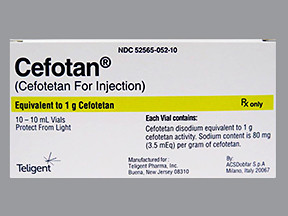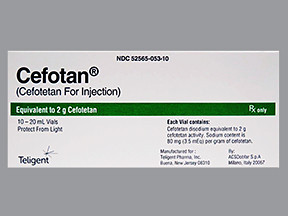CEFOTETAN - INJECTION
PHONETIC PRONUNCIATION: (sef-oh-TEE-tan)
COMMON BRAND NAME(S): Cefotan
GENERIC NAME(S): cefotetan disodium
Uses
USES: Cefotetan is an antibiotic used to treat a wide variety of bacterial infections. It may also be used before and during certain surgeries to help prevent infection. This medication is known as a cephalosporin antibiotic. It works by stopping the growth of bacteria. This antibiotic treats only bacterial infections. It will not work for virus infections (such as common cold, flu). Using any antibiotic when it is not needed can cause it to not work for future infections.
How to use CEFOTETAN - INJECTION
HOW TO USE: Read and learn all preparation and usage instructions supplied by the manufacturer. Follow all instructions for proper mixing with the correct IV fluids. Consult your pharmacist for details. Before using, check the product visually for particles or discoloration. If either is present, do not use the liquid. If you are using the frozen pre-mixed solution, thaw the container at room temperature or in the refrigerator. If the bag is thawed in the refrigerator, let it sit at room temperature at least 1 hour before using. Do not thaw by putting in a water bath or microwaving. After thawing, shake well and squeeze the container to check for leaks. Discard solution if the container leaks. Do not re-freeze the solution after thawing. This medication is given by injection into a muscle or vein as directed by your doctor. For the best effect, use this antibiotic at evenly spaced times. To help you remember, use this medication at the same time(s) every day. The dosage is based on your medical condition and response to treatment. Continue to use this medication until the full prescribed treatment period is finished, even if symptoms disappear after a few days. Stopping the medication too early may result in a return of the infection. Learn how to store and discard needles and medical supplies safely. Consult your pharmacist for details.
Side Effects
Precautions
Interactions
Overdose
Images
Reviews
Disclaimer
IMPORTANT: HOW TO USE THIS INFORMATION: This is a summary and does NOT have all possible information about this product. This information does not assure that this product is safe, effective, or appropriate for you. This information is not individual medical advice and does not substitute for the advice of your health care professional. Always ask your health care professional for complete information about this product and your specific health needs.





No Reviews Yet